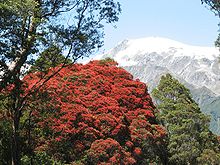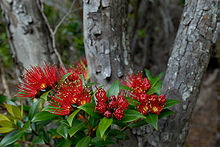- Metrosideros umbellata
-
Southern rātā 
Southern rātā near Franz Josef Glacier Scientific classification Kingdom: Plantae (unranked): Angiosperms (unranked): Eudicots (unranked): Rosids Order: Myrtales Family: Myrtaceae Genus: Metrosideros Species: M. umbellata Binomial name Metrosideros umbellata
Cav.
Distribution of M. umbellata in mainland New Zealand. Auckland Islands not shown. Southern rātā (Metrosideros umbellata), is a tree endemic to New Zealand. It grows up to 15 m. or more tall with a trunk up to 1 m. or more in diameter. It produces masses of red flowers in summer. Unlike its relative, Northern rātā, this species rarely grows as an epiphyte.
Contents
Distribution
It prefers cooler regions with high rainfall and is particularly common along the west coast of the South Island where its nectar is the main source of a locally-produced rātā honey. Southern rātā is the most widespread of the New Zealand tree rātā species. It is locally present in the North Island from lat. 36° southwards, is more common in western parts of the South Island but absent from much of the east, and is common on Stewart Island (47ºS) and in the Auckland Islands where it reaches its southern limit at just over 50°S.
Description
The flowers of Southern rātā are scarlet, with stamens about 2 cm long. White or yellow flowers are also known. Flowering usually occurs between December and February, but this depends on local conditions. Leaves are from 3 to 6 cm long, and are sharply pointed. The wood is hard, dense, and very strong. The bark is rough and flaky and provides an ideal stratum for the roots of epiphytic plants such as Astelia species and Freycinetia banksii (Kiekie). Southern rātā is a major source of honey on the West Coast of the South Island. Kākā, tui, and bellbirds visit rātā to take advantage of the abundant nectar.
Conservation
Although Southern rātā is not regarded as threatened, it is rather uncommon in the North Island, and in certain areas it is threatened by possum browse. In the Tararua range, Southern rātā populations appear to have been replaced by a population consisting of hybrids between Northern and Southern rātā.
Project Crimson is a charitable trust that promotes conservation of rata as well as the related pohutukawa.
Cultivation
Southern rātā is a beautiful specimen tree, but growth can be slow unless it is grown in ideal conditions with moist soil. It is easily grown from fresh seed. While it is possible to grow the tree from softwood or semi-hardwood cuttings, these often prove reluctant to strike roots. It is ideal for coastal environments because it has a good resistance to wind and salt[1].
See also
References
- ^ "Gondwanan Plants What Are They and Why Grow Them in Britain?". Garden Cottage Nursery. http://www.gcnursery.co.uk/gondwana.html. Retrieved 2009-06-18.
- "Metrosideros umbellata". Flora of New Zealand. http://floraseries.landcareresearch.co.nz/pages/Taxon.aspx?id=_42b6cbd7-e582-4f4d-ba21-7d69070266dd&fileName=Flora%201.xml. Retrieved 2007-06-09.
- "Metrosideros umbellata". New Zealand Plant Conservation Network. http://www.nzpcn.org.nz/flora_details.asp?ID=978. Retrieved 2010-10-02.
- "Southern Rata Fact Sheet". Project Crimson. https://www.projectcrimson.org.nz/assets/PDFs/Fact-Sheet-Southern-Rata.pdf. Retrieved 2007-06-09.
Further reading
- Salmon, J.T., 1986. The Native Trees of New Zealand. Wellington: Heinneman Reed.
- Simpson, P., 2005. Pōhutukawa & Rātā: New Zealand's Iron-Hearted Trees. Wellington: Te Papa Press.
External links
Categories:- Metrosideros
- Trees of New Zealand
- Trees of mild maritime climate
- Ornamental trees
- Honey plants
- Flora of the Auckland Islands
Wikimedia Foundation. 2010.

